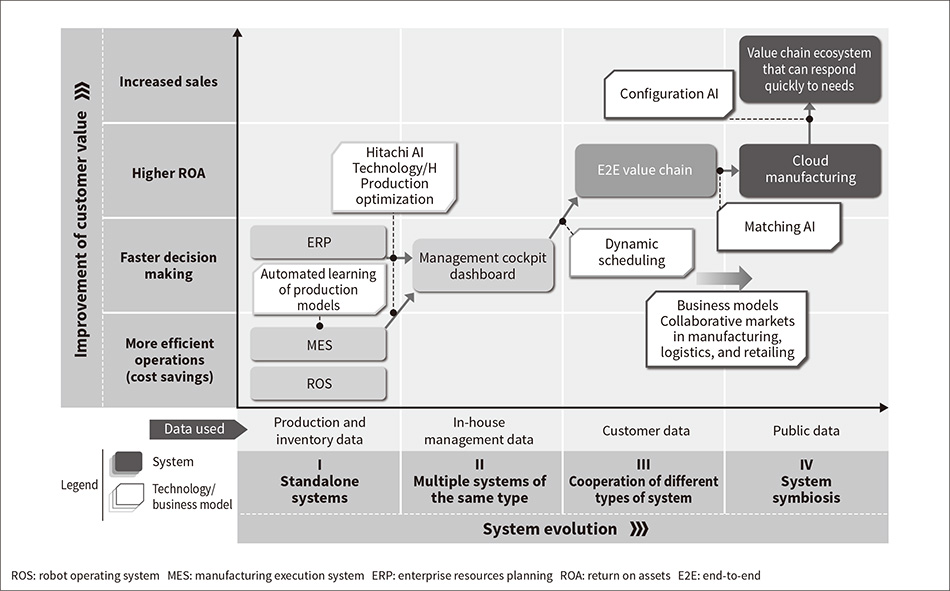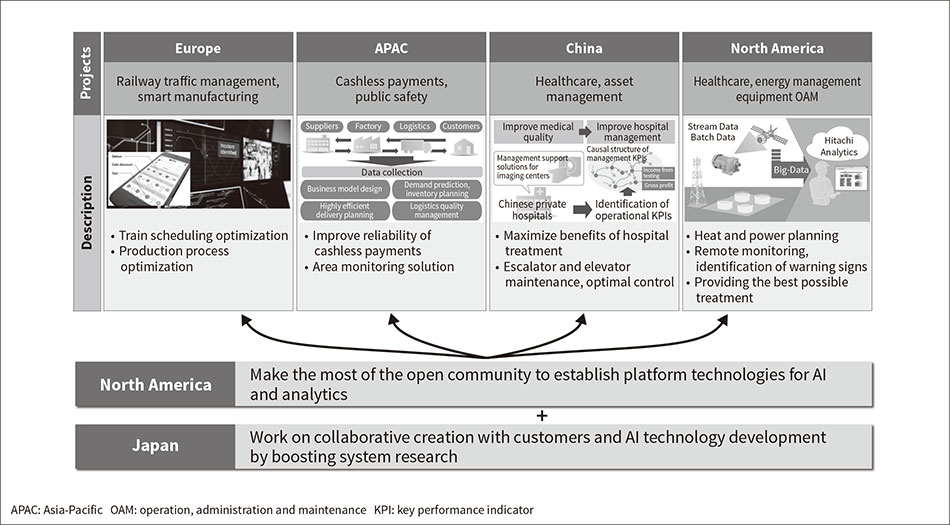Technology Innovation for Accelerating Digital Transformation
The merging of physical space and cyberspace to develop and integrate existing systems more intelligently is crucial to realizing a super smart society and to generating high-level customer value. This article describes Hitachi's research and development strategy for using artificial intelligence and analytics to achieve this, looking at it from the perspective of the evolution of systems. Specifically, Hitachi aims to grow new service platform businesses by boosting cross-disciplinary research in which technology for artificial intelligence and analytics is developed in parallel with value creation, business models, and system architecture design.

Intelligent Information Research Department, Center for Technology Innovation – Systems Engineering, Research & Development Group, Hitachi, Ltd. Current work and research: Research and development of human information systems and AI. Society memberships: The Institute of Electronics, Information and Communication Engineers (IEICE), the Japan Society for Management Information (JASMIN), and the Association for Information Systems (AIS).

Technology Strategy Office, Research & Development Group, Hitachi, Ltd. Current work and research: Formulation of research and development strategy. Society memberships: Fellow of The Institute of Electrical Engineers of Japan (IEEJ), the Society of Serviceology, the Information Processing Society of Japan (IPSJ), and JASMIN.
Work involving the use of the large amounts of big data accumulated by companies and the data collected through the Internet of Things (IoT) to create new customer value and implement in-house operational reforms has become a source of increasing activity in various industries(1). To achieve the vision of a super smart society (Society 5.0) promoted by the Japanese government for the high degree of merging between cyberspace and physical space, Hitachi has plans to develop advanced digital solution businesses (see Figure 1).
This article describes Hitachi's research and development (R&D) strategy for service platforms that it intends to develop, along with the system evolution and advances in artificial intelligence (AI) and analytics that will underpin these platforms.
Figure 1—Digital Solution Businesses Aimed at Achieving a Future Vision
 Hitachi is developing digital solution businesses that use AI and analytics to help realize a super smart society with a high degree of merging between cyberspace and physical space.
Hitachi is developing digital solution businesses that use AI and analytics to help realize a super smart society with a high degree of merging between cyberspace and physical space.
Advances in AI and analytics are contributing not only to more sophisticated interaction with users (user interfaces) as a way of improving services, but also to the incorporation of intelligence into composite systems that work with artifacts (see Figure 2). With the aim of overcoming social issues, it is anticipated that this can deliver greater value and develop progressively, first by assisting with work, expanding capabilities, and replacing labor, and then creating new value.
Figure 2—Value Provided by AI and Analytics
 AI and analytics are applied extensively to overcome social issues both by facilitating more sophisticated interaction with people and by making systems more intelligent.
AI and analytics are applied extensively to overcome social issues both by facilitating more sophisticated interaction with people and by making systems more intelligent.
Past technological advances have included the modeling and application of expert knowledge (first generation), optimization and deductive reasoning (second generation), and inductive neural networks and machine learning that extract feature values from data (third generation). The future will see the development of new fourth-generation AIs that combine these different forms of AI and analytics to be both deductive and inductive (see Figure 3).
Figure 3—Evolution of AI and Analytics Technologies
 The latest AI and analytics are being developed through a combination of deductive and inductive models.
The latest AI and analytics are being developed through a combination of deductive and inductive models.
A study by the Japan Electronics and Information Technology Industries Association predicted that the market for AI will grow rapidly to reach 318 trillion yen in 2025 (with AI-equipped robots accounting for 130 trillion yen), with extensive business opportunities anticipated across various industries (see Figure 4). As the role of AI evolves from assisting with work to creating new value, it is anticipated that the business opportunities will also shift away from supporting human roles to replacing them, with the emergence of inter-system interactions and transactions that do not involve human intervention.
Figure 4—Business Opportunities for AI and Analytics
 There are growing business opportunities for AI and analytics in a variety of business domains.
There are growing business opportunities for AI and analytics in a variety of business domains.
While the use of AI and analytics is spreading to many different industries, as noted above, in all of these cases it is no more than a means to realize new value. When looked at another way, AI and analytics can be seen as providing the essential technical foundations for all sorts of different innovations. That is, the R&D strategy for these technologies will serve as the basis for a wide variety of technology development in today's advanced information societies.
Figure 5 shows the steps involved in formulating this R&D strategy. Rather than pursuing trends in technology as such, it is necessary to start by asking what type of customer value is desirable and in which cases should it be created. Once hypotheses for customer value are established, the next step is to construct hypotheses for the system evolution needed to achieve this value. The term “system” is used here not only in the sense of artifacts built from a combination of computers and machinery, but also in the sense of a so-called business ecosystem(3), (4). That is, it is made up of three layers: the mechanisms used to create value, the artifacts that make this possible, and the agents that provide these artifacts. Once the hypotheses for system evolution are constructed, the next step is to determine the specific technologies for AI and analytics that will serve as the enablers for the artifacts in the second layer. Of course, systems require more than just technology. The construction of a sustainable ecosystem also needs to consider things like economics, rule-making, and how to involve customers and partners. Hitachi intends to flesh out its technology development strategy by combining these things with the various different enablers.
The next step is testing the hypotheses. This includes prototyping and social experiments, and means going back to earlier steps if a hypothesis is rejected. Given that R&D work is a core aspect of this step, it may seem odd to treat it as part of strategy formulation. However, in the era of digital transformation, there is a need for the agility that comes from continually reviewing strategy throughout the R&D process. In other words, strategy formulation and R&D will become increasingly integrated. The key to competitiveness in technology development lies in how quickly the organization can work through the cycle shown in Figure 5.
Figure 5—Steps in Formulating R&D Strategy
 To formulate this research and development strategy, consideration starts from the clarification of customer value.
To formulate this research and development strategy, consideration starts from the clarification of customer value.
Hitachi has systematized its NEXPERIENCE methodology for collaborative creation with customers and developed a variety of tools and other methods for establishing the initial hypothesis shown in Figure 5(5). NEXPERIENCE covers a wide range of different phases, from identifying customer issues and coming up with service ideas to simulating business value.
As people's values become more diverse and complex, it is no longer the case that clear values exist that are shared by everyone. At the highest level, there are the Sustainable Development Goals (SDGs) that were chosen as common targets for international society by a United Nations summit(6). When attempting to break down these goals into specifics, however, it is difficult to obtain a consensus of opinion due to various differences, whether it be at the national or individual level. Given this confusion and lack of clarity about value, it is essential to use data to make value more visible when establishing hypotheses about value. That is, AI and analytics are useful for formulating technology strategies about AI and analytics.
The starting points for considering the evolution of systems for realizing value are to ask where value arises from and what path it follows. Figure 6 shows how systems have evolved in macro terms. It shows a shift from the level of creating and consuming value within standalone systems to the level of sharing value among a system of peers. This is followed by evolution into a “system of systems” in which different systems with the same objectives work together. The final stage is a state of symbiosis between systems in which a beneficial co-existence is achieved by different systems with different objectives operating harmoniously to the extent that their respective objectives allow(7).
Typically, the more that is done to increase the value of a system, the more it evolves to become complex. The configuration of systems at the standalone level, for example, typically involves an exchange of products and services that incorporate value between suppliers and users, and is not complex enough to be called an ecosystem. At the level of system symbiosis, on the other hand, value arises out of the comprehensive interactions between a number of interested parties. This makes necessary not only the development of technologies for creating value, but also designs that take account of how these technologies are incorporated into systems.
The following section describes specific measures applicable to the industrial field.
Figure 6—System Evolution
 Improvements in customer value are achieved through the interaction of the evolution of the system and the evolution of AI.
Improvements in customer value are achieved through the interaction of the evolution of the system and the evolution of AI.
Figure 7 shows the evolution of systems in the industrial field. Business process outsourcing services and ecosystems become more sophisticated by using data to learn operational rules. With regard to making factories smarter, what this actually means is greater automation of work with increasing assistance and replacement of human labor. For the automation of operations, it means automation of the production model and automatic scheduling, and consideration of the entire supply chain. As this automation of factory work and operations becomes more sophisticated it leads to cloud manufacturing with the adoption of just-in-time practices and the automation of production and operations in ways that enable mass customization.
Figure 7—Industrial Business Opportunities and System Evolution
 Business process outsourcing services and ecosystems become more sophisticated by using data to learn operational rules.
Business process outsourcing services and ecosystems become more sophisticated by using data to learn operational rules.
Advances in AI for production optimization and automated learning of production models that uses man, machine, and material (3M) data from manufacturing plants to improve the accuracy and transparency of production planning are followed by progress in dynamic scheduling, which identifies highly effective actions automatically (see Figure 8). It is anticipated that these advances will both improve the cash conversion cycle and provide a better return on assets through higher plant utilization. To achieve mass customization, this will be followed by business systems, which were previously restricted to individual factories or companies, being integrated on the cloud in the form of symbiotic autonomous decentralized systems. The construction of end-to-end processes that span multiple companies will be automated by matching AIs equipped with autonomous decision-making functions.
Figure 8—R&D Strategy for the Industrial Field
 The strategy starts with localized optimization with a long-term aim of automating the entire supply chain.
The strategy starts with localized optimization with a long-term aim of automating the entire supply chain.
The following sections describe some representative examples of AI and analytics technologies that Hitachi is developing.
Hitachi is developing a planning technology that uses constraint programming, which is a type of mathematical programming technique(8). Applied to the prediction of train movements, this can calculate train schedules by modeling operations, signal status, train speed, and other operating conditions in the form of constraint equations. The technique is used on actual railway lines to support safe and punctual daily train service.
Hitachi is developing the EMIEW3 humanoid robot to provide service support, including serving and advising customers in shopping centers and other public spaces(9). Along with providing interactive and advisory capabilities in stores that can be used to help customers find particular products or to offer them recommendations, Hitachi is also looking at how to link this customer service with sales management systems.
This AI performs statistical processing to identify complex correlations contained in data by generating an exhaustive set of input data combinations and performing a round-robin calculation of the relationships between the combination feature values and outcomes(10). A feature of the AI is that it does not depend on tuning or modeling based on domain knowledge. It is being deployed in various industrial fields.
Along with seeking to develop new AIs that are based on a combination of both deduction and induction, as described above, Hitachi aims to trigger a virtuous circle of activities by having its global research team, Insights Laboratory, work on acquiring and consolidating knowledge from different regions around the world. In particular, this includes making greater use of the open community based around the Big Data Laboratory in North America (see Figure 9). These tools, know-how, and use cases will continue to accumulate on Hitachi's IoT platform, Lumada.
Figure 9—Global Expansion
 The Insights Laboratory global research team is acquiring and consolidating knowledge from different regions around the world. Hitachi is establishing the platform technologies by utilizing the open community based around the Big Data Laboratory in North America. Use cases are being developed for enhancement projects in each region.
The Insights Laboratory global research team is acquiring and consolidating knowledge from different regions around the world. Hitachi is establishing the platform technologies by utilizing the open community based around the Big Data Laboratory in North America. Use cases are being developed for enhancement projects in each region.
This article has described an R&D strategy for AI and analytics from a fresh perspective that will accelerate the pace of system evolution.
New customer value will be created through the interaction between system evolution and AI and analytics. Hitachi intends to pursue these through cross-disciplinary research that works on business models, system architecture design, and AI technology development in parallel.